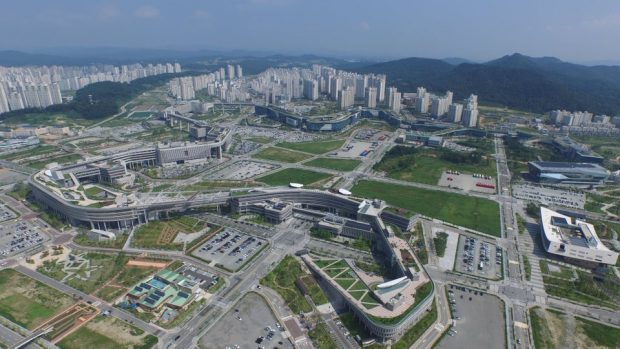South Korea unveils record high budget for 2020

Sejong
Sejong: South Korea on Thursday proposed a record 513.5 trillion-won ($423.7 billion) budget for 2020 to boost its slowing economy beset by a deepening U.S.-China trade row and more recently its own with Japan.
The expansionary budget – endorsed by the Cabinet – represents a 9.3 percent hike from 2019 and marks the second straight year that the budget proposal has risen by more than 9 percent.
A key centerpiece of the spending proposals is 24.1 trillion won set aside for research and development (R&D) in 2020, which is up 17.3 percent from 2019. The increase is the highest in a decade.
The R&D spending calls for, among other things, the localizations of key industrial materials, parts and equipment to reduce South Korea’s heavy reliance on Japan, while securing new growth engines for Asia’s fourth-largest economy, in such sectors as artificial intelligence, bio-health, future vehicles and fifth-generation network services.
In July, Tokyo imposed tighter regulations on exports to Seoul of three materials – resist, etching gas and fluorinated polyimide – that are critical to produce semiconductors and flexible displays.
Japan later removed South Korea from its “whitelist” of trusted trading partners in retaliation against last year’s South Korean Supreme Court rulings ordering Japanese firms to compensate South Korean victims of forced labor during Japan’s 1910-45 colonial rule of the Korean Peninsula.
Concerns have mounted that Japan’s export curbs could add more uncertainty to and weigh on Asia’s fourth-largest economy, already struggling with falling exports that have been in a slump since December.
Hong Nam-ki, the minister of economy and finance, has said recently that in the face of the mounting American-Sino trade war, coupled with Japan’s export restrictions, “it won’t be easy” for South Korea to pull off its 2.4 percent or 2.5 percent growth target, which was revised from its previous forecast of between 2.6 percent and 2.7 percent in December.
The South Korean economy grew 1.1 percent on-quarter in the second quarter of the year, after unexpectedly backtracking 0.4 percent in the January-March period, hit by a decline in prices of semiconductors, a key export item for the country, sullen facility investment and weak demand from China.
The Bank of Korea cut its policy rate by a quarter percentage point to 1.5 percent last month, citing worsening external conditions, and also slashed its growth outlook to 2.2 percent from the previous 2.5 percent.
The central bank is widely expected to deliver another rate cut this year.
The ministry said total revenue is projected to rise 1.2 percent on-year to 482 trillion won in 2020, and it plans to issue 60.2 trillion won worth of state bonds to cover the shortfall.
The fiscal deficit is estimated at 3.6 percent of the country’s gross domestic product (GDP) next year, compared with 1.9 percent for 2019, while the national debt-GDP ratio will rise to 39.8 percent from 37.1 percent over the cited period.
Under the proposal, 23.9 trillion won was earmarked to boost exports and investment, and to help create startups and nurture local unicorn companies.
Earlier this year, President Moon Jae-in announced an ambitious plan to increase the number of South Korean unicorn companies to 20 by 2020 from the current six, which includes Coupang, a top e-commerce company.
The budget proposal also includes 22.3 trillion won to improve roads, railroads and social infrastructure, and to build public libraries, and community sports and cultural centers.
The government earmarked 25.8 trillion won for job creation, sharply up 21.3 percent from 2019, which underscores the government’s efforts to create more jobs amid disappointing jobs data in recent months and worsening economic conditions.
South Korea’s jobless rate rose to 4 percent in June, the highest level for any June since 1999. The unemployment rate for young adults — those aged between 15 and 29 — rose 10.4 percent in June from 9 percent tallied a year earlier.
The government allocated 50.2 trillion won for military spending to strengthen defense capabilities against nuclear and missile threats posed by North Korea. It marked the first time that the defense spending surpassed the 50 trillion-won mark.
South Korea’s arms buildup includes the introduction of 40 F-35A fighter jets from the U.S. by 2021. So far, South Korea received six stealth fighter jets.
Tensions persist on the Korean Peninsula over the North’s launches of missiles and other projectiles in recent months.
Still, South Korea earmarked 5.5 trillion won for inter-Korean economic cooperation projects, public diplomacy and official development assistance programs for developing countries, up 9.2 percent from 2019.
The government also plans to raise budget spending in the health care, welfare and labor sectors by 12.8 percent on-year to 181.6 trillion won, accounting for the lion’s share in the budget proposal.
For education, the government proposed to spend 72.5 trillion won next year, up 2.6 percent from 2019. The hike is partly to cover gradual free education for high school students.
The free education will cover the second and third grades of high school in 2020 before being expanded to all high school students in 2021.
The budget proposes boosting environmental spending by 19.3 percent to 8.8 trillion won to tackle, among other things, fine dust pollution that blanketed South Korea earlier this year.
Fine dust has sparked health concerns across the country as it can cause various respiratory diseases and undermine the body’s immune system.
The government is set to submit its budget proposal to the National Assembly on Tuesday for approval, whose deadline is Dec. 2.
At least 149 out of 297 lawmakers need to be present at the parliament to put a bill to a vote in a plenary session. A majority of votes, at least 75, is needed to endorse the measure, according to the National Assembly’s procedures.
The ruling Democratic Party has 128 seats, with the main opposition Liberty Korea Party holding 110, and minor opposition parties and independents accounting for 59.
YONHAP

























































